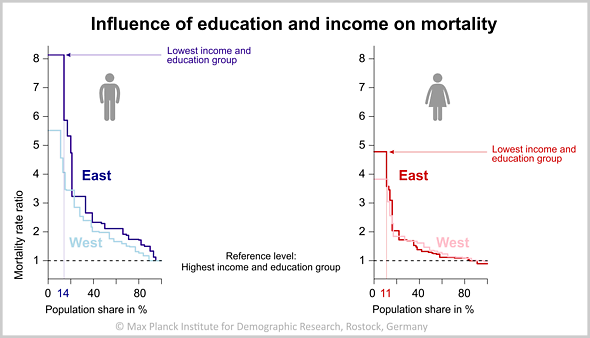October 08, 2019 | Press Release
Highest mortality risks for poor and unemployed

© french_03 photocase.com
For the first time, researchers calculated reliably how mortality in Germany depends on education, income or employment status. According to this, unemployment doubles the risk to die. And the death risk for the most disadvantaged group, men in the East, is eight times as high as for the most advantaged group.
How do factors like education, income and employment status influence the mortality risk of employees in Germany? Pavel Grigoriev, Rembrandt Scholz and Vladimir M. Shkolnikov, researchers at the Max Planck Institute for Demographic Research (MPIDR), have calculated this reliably for the first time, using a public dataset from Deutsche Rentenversicherung, the German mandatory state pension insurance, which includes information from several million insured persons. Their results have just been published in the journal BMJ Open.
“For the first time we have a solid foundation in data to rate the different factors and their influence on mortality in Germany,” says Pavel Grigoriev. Earlier studies for Germany had used considerably smaller datasets obtained from surveys that were less significant.
East or West Germany? That’s not a factor per se
The new results underline how important it is to have a job: unemployment doubles the mortality risk. Even more important is income, especially for men: the mortality of the twenty percent with the lowest income was 150 percent higher than for the twenty percent who made the most money. A bad education, on the other hand, only raises the mortality risk for men by 30 percent.
The mortality rate is the probability to die within the next year – independent of age. To make the mortalities of different groups comparable, the researchers accounted for the influence of age. For example, unemployed people on average are older than people who have a job and naturally have a higher death risk. The age structure of all population subgroups was adjusted statistically so that they all had the same composition. That way, the differences in mortality could be ascribed to the remaining factors like unemployment or income.
“The region of residence has a negligible influence on mortality,” says Pavel Grigoriev. While the mortality rate in the East is 25 percent higher for men than in the West, that difference vanishes when you take into account the effects of unemployment, education, income and nationality.
The reason for the higher mortality of men in the East is that they have a larger share of people who are unemployed or less educated or have a low income. All these factors raise the mortality. Other differences between East and West, like the medical infrastructure, seem to play a negligible role.
East Germany: eightfold mortality rate for men with the lowest status
How extremely the socioeconomic status influences the chance to survive, especially income, employment status and education, can be demonstrated in the most disadvantaged group of men in the East: 14 percent belong to the lowest strata regarding income and education. Their mortality rate is more than eightfold of those in the highest strata. In West Germany, this most disadvantaged group among men is smaller and comprises 11 percent, and their mortality rate is only a little more than five times that of the most advantaged group. So at least for men, the mortality rate in the East is distributed more unevenly than in the West. Nevertheless, in the West income and unemployment also influence the mortality rate considerably.

This figure shows the mortality risk under the influencing factors income level and educational level for men and women in East and West Germany in 2013. This results in 20 different income and education groups, all of which are related to the reference value 1, the group with the highest education and the highest income.
In East Germany, 14 percent of men belong to the group with the lowest income and the lowest education. Compared to the group of men with the highest income and the highest education, they have an eightfold risk of dying. © MPIDR/Pavel Grigoriev
Among women, the differences are less pronounced, especially considering income. Unemployment and education have a similar impact on mortality as with men.
The MPIDR researchers reached their conclusions on the social context of mortality, which are unique for Germany, by evaluating the social security data of 27 million employees. They collected anonymized information on all insured persons in Germany that were between 30 and 59 years old in 2013.
German data protection rules preclude better knowledge on mortality rates
Compared to other countries, especially in Scandinavia, Germany lacks the access to data. Figures about the connection between mortality and socioeconomic status are especially hard to come by, says Grigoriev. “This is because of the strict interpretation of privacy regulations regarding governmental datasets on the German population.”
In Germany, it is not allowed to connect personal data between different government agencies. For scientists, those data could be an important source for their research, that ultimately contributes to improving the well-being of people and populations. “In Germany, different institutions collect big amounts of data, using a lot of resources and taxpayers’ money, it’s not only demographic research could profit if this information was more accessible,” says Grigoriev.
For Grigoriev, there is no mistaking that the scientific evaluation of these datasets should only be allowed if they are completely anonymized and the identification of individual people is absolutely impossible. This is achievable with information technology, he says, and wouldn’t violate the European General Data Protection Regulation (GDPR). Ultimately, demographic research is not interested in individual people’s data, it only uses it as an intermediate step to calculate results for big groups of people – like the mortality for different income strata.
About the MPIDR
The Max Planck Institute for Demographic Research (MPIDR) in Rostock investigates the structure and dynamics of populations. The Institute’s researchers explore issues of political relevance, such as demographic change, aging, fertility, and the redistribution of work over the life course, as well as digitization and the use of new data sources for the estimation of migration flows. The MPIDR is one of the largest demographic research bodies in Europe and is a worldwide leader in the study of populations. The Institute is part of the Max Planck Society, the internationally renowned German research organization.
Original publication
Grigoriev, P., R. Scholz, and V. M. Shkolnikov: Socioeconomic differences in mortality among 27 million economically active Germans: a cross-sectional analysis of the German Pension Fund data. BMJ Open. DOI: http://dx.doi.org/10.1136/bmjopen-2018-028001
Associated Information for Download
Graphics:
Influence of Education and Income on Mortality (PNG File, 298 kB)
Influence of Education and Income on Mortality (PDF File, 1 MB)
Press release:
Highest mortality risks for poor and unemployed (PDF File, 164 kB)
Contact
Press and Public Relations